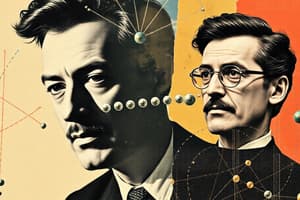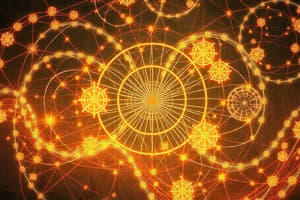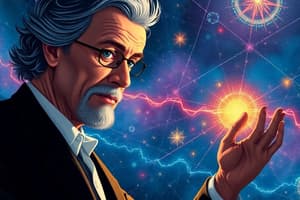Podcast
Questions and Answers
What concept is primarily represented by Feynman diagrams in quantum mechanics?
What concept is primarily represented by Feynman diagrams in quantum mechanics?
- Visual representation of theoretical particle interactions (correct)
- Detailed calculations of electromagnetic forces
- Graphical illustrations of physical laws
- Mathematical proofs of quantum indeterminacy
What major advancement in quantum electrodynamics (QED) did Feynman contribute to in 1948?
What major advancement in quantum electrodynamics (QED) did Feynman contribute to in 1948?
- A formula describing the interaction between charged particles and electromagnetic fields
- A graphical approach to visualize complex interactions between electrons and photons (correct)
- A new method to compute probabilities using random walks
- The complete unification of electromagnetism and gravitation
Which field did Feynman’s theories help influence beyond quantum electrodynamics?
Which field did Feynman’s theories help influence beyond quantum electrodynamics?
- Astrophysics and cosmology
- Classical mechanics
- Thermodynamics and statistical mechanics
- Nanotechnology and superfluidity (correct)
How did Feynman contribute to the investigation of the Challenger disaster?
How did Feynman contribute to the investigation of the Challenger disaster?
In the context of Feynman diagrams, what happens to many of the probabilities calculated?
In the context of Feynman diagrams, what happens to many of the probabilities calculated?
What year was the model for classifying subatomic particles proposed by Gell-Mann?
What year was the model for classifying subatomic particles proposed by Gell-Mann?
Which of the following correctly describes the two main groups that Gell-Mann distinguished in his model?
Which of the following correctly describes the two main groups that Gell-Mann distinguished in his model?
What hypothetical fundamental unit did Gell-Mann invent to enhance his particle classification system?
What hypothetical fundamental unit did Gell-Mann invent to enhance his particle classification system?
What is the primary purpose of Feynman diagrams in physics?
What is the primary purpose of Feynman diagrams in physics?
What prestigious award did Gell-Mann receive for his contributions to theoretical physics?
What prestigious award did Gell-Mann receive for his contributions to theoretical physics?
What significant award did Richard Feynman receive in 1954?
What significant award did Richard Feynman receive in 1954?
What was a key aspect of Feynman's early education?
What was a key aspect of Feynman's early education?
In which year did Feynman become a professor of theoretical physics at Caltech?
In which year did Feynman become a professor of theoretical physics at Caltech?
Which major project did Feynman participate in during World War II?
Which major project did Feynman participate in during World War II?
What topic did Feynman publish his lectures on in 1964?
What topic did Feynman publish his lectures on in 1964?
What was one of Feynman's contributions to the field of physics recognized by the Nobel Prize in 1965?
What was one of Feynman's contributions to the field of physics recognized by the Nobel Prize in 1965?
What motivated Feynman to participate in the Manhattan Project?
What motivated Feynman to participate in the Manhattan Project?
How did Richard Feynman explore mathematical theories in his early life?
How did Richard Feynman explore mathematical theories in his early life?
Flashcards are hidden until you start studying
Study Notes
Early Life and Education
- Richard Feynman was born in New York to parents of Lithuanian Jewish descent
- He demonstrated strong mathematical capabilities at an early age using gadgets to explore mathematical theories
- Feynman was refused admission to Columbia University due to quota restrictions, attending MIT instead where he studied mathematics then physics
- He received his PhD in quantum mechanics at Princeton, scoring perfectly on his Physics exams
Career and Contributions
- Feynman was appointed a junior physicist in 1943 and worked on the Manhattan Project at Los Alamos
- In 1950, he became a professor of theoretical physics at the California Institute of Technology (Caltech)
- He received the prestigious Albert Einstein Award in 1954
- Known for his engaging lectures, Feynman's Caltech lectures were published in 1964 as the Feynman Lectures on Physics
- In 1965, he was awarded the Nobel Prize in Physics (jointly with others) for his work on Quantum Electrodynamics (QED)
- He made significant contributions to the understanding of quantum mechanics and physics, revolutionizing the way complex ideas are understood
- Notable for introducing Feynman diagrams, a visual representation of quantum processes, simplifying complex equations for particle physics
- He played a pivotal role in improving the Quantum Electrodynamics (QED) theory
- His work on QED helped to describe the interactions of electromagnetically charged particles, exchange of photons, and other significant mathematical calculations
- Despite the initial success of the theory, some mathematical inconsistencies were later noted in the early theories
- Feynman's work extended beyond QED, influencing fields like nanotechnology, superfluidity and also explaining the Challenger disaster
Manhattan Project and Secret Bomb Research
- Feynman participated in the Manhattan Project from 1942-1945, working on nuclear weapons research
- Driven by concern about the possibility of Nazi victory, he joined the research program
- He also conducted secret bomb research at Los Alamos National Laboratory and lived in the laboratory's trailer parks
- Feynman later taught at Cornell University as a Professor of theoretical physics
Murray Gell-Mann
- Murray Gell-Mann, a polymath and leader in theoretical physics at Los Alamos at the age of 24, accurately described particle interactions to 15 decimal places
- He combined his talents in languages abstract thinking, and particle physics to develop a system for classifying subatomic particles
- Gell-Mann proposed in 1964 a model for classifying subatomic particles, distinguishing between:
- Fermions: Building blocks of matter.
- Bosons: Force carriers.
- He created the term ‘quark’, a hypothetical fundamental unit, now considered a type of fermion, which combine to form hadrons (protons and neutrons)
- Later experimental evidence confirmed the existence of quarks, supporting Gell-Mann's model
- His model is now known as the "standard model" and was awarded the 1969 Nobel Prize in Physics.
Feynman Diagrams
- Feynman diagrams, abstract concepts in physics, are visually represented as charming squiggles
- Feynman's use of diagrams simplified complex concepts, used for understanding particles in events such as the Large Hadron Collider
- His Caltech lectures were popular and used in writing a well-received physics textbook
Studying That Suits You
Use AI to generate personalized quizzes and flashcards to suit your learning preferences.





